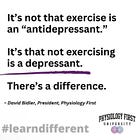A Guide to Treating Symptoms of Mental and Physical Illness (Continued...)
PART IV: Pursue Virtue & Usefulness, and Happiness May Follow
I recently remembered that I had begun this brief writing series. I often begin multi-part writing tasks and have my attention wrenched away halfway through… and then my interest in the subject has waned and so I leave the series incomplete. I probably have hundreds of such ideas and prompts lying around in notebooks-just because I haven’t finished them yet doesn’t mean I never will. It seems that this topic is always close to the forefront of my reflections these days though.
An image, from a time before neurosis
The Fall of Psychology
Psychology as a field is a complete mess in our society. P-hacking, the replication crisis, the widespread lack of evidence for the efficacy of talk therapy (which probably represents most of the clinical activity in the field)… these are serious issues which should have provoked a serious re-examination of the field’s priors. The real problems are actually much deeper though.
As an advertisement for the intellectual and moral bankruptcy of modern psychology I can think of no failing more tragically glaring than the professional ‘treatment’ of gender dysphoria. Therapists have been helping patients explore and manage gender dysphoria and transsexual ideations for many decades. Unfortunately the juvenile patient profile has shifted dramatically in the past decade (from 70-80% effeminate boys who generally struggled with GD for years and who usually ended up as gay men to 70% girls-disproportionately autistic and with other pre-existing mental health diagnoses-whose GD complaints often appeared more suddenly and sometimes in the context of peer or friend group gender exploration. We don’t know what will become of these girls, some significant percentage of whom are probably not trans, in full sense of the word. It’s a harrowing question). The social and ideological changes which partly underly this shift have also saturated the ranks of American therapists. I haven’t seen any data which indicate the share of working therapists who endorse the strange set of beliefs known as ‘gender ideology’ but-considering that the profession is fairly young, female, and liberal-I would almost be surprised if the gender ideologues didn’t represent the majority. Like anti-racism or democratic socialism, gender ideology seems to appeal to the empathetic and virtue-advertising elements in the female mind. Unfortunately ideas that may seem kind and tolerant and beliefs which have social cachet are no more likely to be true or helpful or incisive… and a theory about people based upon wishful thinking or good intentions can create hellish scenarios in short order.
We have a situation in which thousands of adolescent girls are presenting with GD and, instead of being carefully examined, are quickly being “affirmed” and begun on a conveyer belt to puberty blockers and hormones and (sometimes) surgery. Data seems to indicate that most of the adolescents being treated for GD are receiving drugs… which seems completely insane, given that ~85% of the cases resolve naturally during adolescence. What exactly is being “affirmed”? The idea that we all have an interior gender identity which is a personal and distinct psychological structure isn’t even unscientific-it’s frankly mystical, and it seems to run into problems upon the most cursory glance at sexual anthropology. The idea that ‘trans’ is a biologically-based phenomenon is highly doubtful and there seems little use in a “gender identity” which can diverge from one’s physiology under the influence of mysterious or random forces. The bottom line is that > 99% of people who have lived have conformed to their culture’s ideas of masculinity and femininity, and nearly every society which we know of has featured a binary sex regime. Even the much-touted “exceptions” (like the Hegira in certain parts of India) are actually exceptions within a binary system. The Hegira are men (often gay) and hermaphrodites who live as women and fulfill certain religious roles. The ideas of men living as women (or vice versa) to access magical resources or explore the collective unconscious is actually not very rare throughout history. However, no one believed they were women, and their claim to the feminine social role wasn’t anchored in a subjective sense of womanhood. Literally every pre-modern society that I’m aware of would regard this kind of gender blurring as incoherent. Trans is an idea that has existed for perhaps 100 years. Non-binary (which I don’t believe is a meaningful or coherent identity) has existed for perhaps 15.
So there are serious issues with social contagion among adolescents presenting with GD, issues which are going fairly unaddressed. In many professional circles the idea of social contagion is itself transphobic. However, I have not heard a different plausible explanation for the dramatic swing in the composition of young GD patients. There is absolutely no science behind gender ideology. Worse still, the ideas which are being presumed and defended by the therapists and psychologists and professional bodies are ideas which only existed in the outer fringes of society. It’s difficult to see what has changed, other than a fashionable sense of ‘tolerance’ and progress. At gender clinics adolescents are often referred to endocrinologists almost unanimously. Many of the whistleblowers who are beginning to come forward in the U.S. (and dozens who tried to raise the alarm for years at the British youth gender clinic, NIH’s Tavistock) report almost no treatment or therapy being performed. In the minds of these clinicians their role seems almost exclusively to be to explore and “affirm” their patients’ genders. Perhaps most appallingly, the reason for this monomania and intolerance of any path other than “affirmation” is the possibility of comorbid mental health symptoms and suicide among trans people. I’ve spent some time reviewing the data and came away deeply uneasy: trans people have a greatly elevated suicide risk, certainly, but it’s in the range of people suffering with other serious mental illnesses (bipolar disorder, schizophrenia, etc.). The scandalous fact is that the data in favor of medical transition as a suicide prevention measure is extremely thin and ambiguous. Furthermore, the subjects in those experiments were the old cohort of individuals reporting persistent (childhood onward) gender dysphoria. I can’t see any way that the newer type of patient, the teenage girl who has autism spectrum disorder and who exists in a pathological social environment which is putting unprecedented strains on her mental health and simultaneously suggesting that trans is an original identity signifier which is almost heroic and will yield fast social capital.
Obviously this is a failure of science, but it’s far more profound and expansive than the adoption of incorrect theories or the ignoring of conflicting bodies of evidence. This is a field which has profoundly misunderstood its role and discarded any pretense of evidentiary basis in favor of fealty to a novel religion, with all the intolerance and tribalism typical of religions. How has psychology collapsed and degraded itself so completely?
I’ve written elsewhere about the strange emptiness at the heart of many psychological interventions. If you’re anxious or insomniac or socially awkward or explosively angry then your engagement with psychology might be an extended effort to ameliorate those symptoms, to increase your functional ease as you move through life. There are different ways this can be done but the primary tool in the therapist’s kit (I use psychologist and therapist interchangeably here, since therapy is basically the clinical practice of psychology in the context of direct and conversational work with the patient) is talk therapy. Talk therapy can be unstructured, self-indulgent, wasteful, and counter-productive and the evidence that this modality is helpful for patients in the aggregate is scandalously thin. Unsurprisingly, many people opt for the FDA-sanctioned shortcut: psychopharmacological medication. Unfortunately the grave sickness at the heart of psychology infects psychiatry as well and has led the field into a progressively tighter and bleaker corner for more than a generation.
What are the fixes? I would submit that psychology has wandered off-course because it never focused on the right project. Growing alongside an individualistic and increasingly pathological consumerist society it might have been inevitable that the field would be mired in self-indulgence and subjectivity. It was certainly inevitable that any field which tried to ‘scientize’ consciousness or subjectivity or the unconscious would turn into gobbledygook. Those are concepts which still lie well outside the realm of scientific understanding (and the state of our research institutions at this time is bringing us no closer, I suspect).
Eudaemonia, as a Healing Concept
I will get to the point: psychology should concern itself with making functional and virtuous and socially adjusted humans, and let happiness and fulfillment largely work itself out. A person who is useful and busy and surrounded by her fellows and blessed with productive relationships is unlikely to be chronically unhappy, and if she is it’s probably beyond the scope of much of what we understand as psychology today anyway. We need to rediscover the concept of virtue. I believe that much more than the fortune of psychology as a field of study and treatment depends upon this. I’ve written about this elsewhere. Years ago I wrote:
The ancient Greeks had a body of philosophical inquiry known as eudaimonia: the science of living a fulfilling or virtuous life. This is a subject that has almost entirely disappeared from our cultural landscape as far as I can tell. There are endless podcasts about increasing happiness or productivity or health but those are quite separate concerns. We can conceptualize those areas as the ‘means’; how will we achieve our goals and manage our time and enjoy or work and pastime? There is a deeper level of inquiry, though, that seems to be rarely treated in our collective dialogue. What are the ends?
How do we conceptualize virtue and move towards that concept? Presently we probably talk about virtue (or its equivalents) less than any society which has ever existed.
We can add a conception and practice of virtuous living to the list of recommendations in my guide.
To recap: our society is increasingly lonely and neurotic and, rather than addressing those conditions or seeking to heal or strengthen our citizens our consumerist economic structure has tried to profit from their unhappiness and unfulfillment and insecurities. The structure feeds us more food than we need (especially sweet or indulgent food) and then sells us products or plans or clothes to deal with the degeneration of our physical form. The structure encourages us to pursue aimless and fluorescent-lit jobs and then sells us medications for focus, or apps for productivity, etc. The available examples are nearly endless. In all of these areas we see the same pattern:
Our desires > Create a feeling of craving or insufficiency > Requires a costly salve > Which creates more problems > Which creates desires…
Around and around we go.
“Craving and desire are the cause of all unhappiness. Everything sooner or later must change, so do not become attached to anything. Instead devote [yourself to virtue].
…
In the end, only three things matter: how much you loved, how gently you lived, and how gracefully you let go of things not meant for you.
Your mind is a powerful thing. When you filter it with positive thoughts, your life will start to change.
-The Buddha
Conclusion
We need to recognize that we are animals who evolved to live in certain ways and find fulfillment in certain areas and when we detect progressive and chronic deficits in our wellbeing it pays to examine how our lifestyles have deviated from that evolution: sunshine, activity. food (not too much, mostly plants), company, useful activity, a virtuous and natural life. This is not an original point and it’s one that I see made increasingly often, which encourages me greatly.
We are social animals, yet we are treated as individual units by our healthcare providers
Instead of buying things to improve our lives we should focus on activity and usefulness and human company and cultivating virtue. Give it a try for a few weeks and see if your life doesn’t begin to feel happier, more natural, better.
What do you have to lose? As a man making a rather different point once wrote: “unite; you have nothing to lose but your chains.”
In the final two parts of this series I will: describe the process and rewards of self-discipline and lay out some basic recommendations which should help those suffering from mental and physical illnesses. They certainly won’t hurt.










